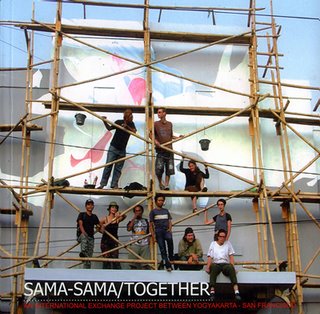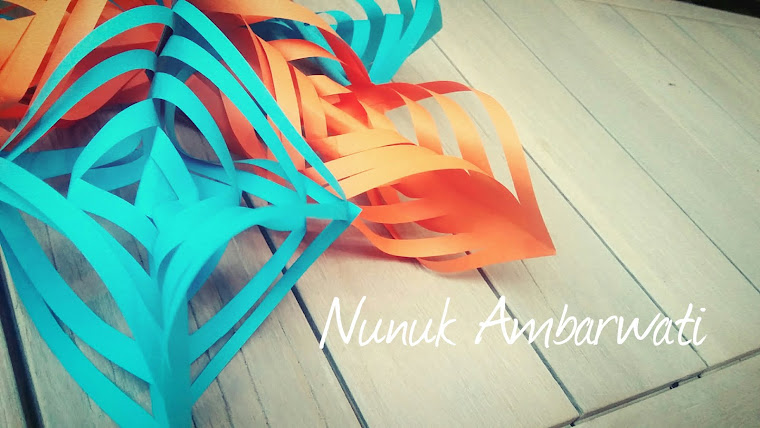
Library Room, Jogja Gallery, Saturday, October 7, 2006
By Nunuk Ambarwati
By Nunuk Ambarwati
On the Subject of Apotik Komik
In the series of grand launching Jogja Gallery (JG) and visual arts exhibition “ICON: Retrospective” −curators: Mikke Susanto and M. Dwi Marianto− from September 19 until November 19, 2006, JG launched a book entitled Mural Sama-sama/Together published by Kelompok Apotik Komik and Clarion Alley Mural Project (CAMP), San Fransisco, declaring a public statement on the disbandment of the group. In my opinion, the formation of its membership fluctuates, easy comes easy goes so that it is quite hard to identify who the members are. However, JG managed to present some individuals who used to be the members of ex-Apotik Komik represented by Arie Dyanto, Samuel Indratma, Arya Pandjalu, Nano Warsono but without the presence of Ade Tanesia and Mie Cornedeus as scheduled in the publication previously released. The four people began the program by presenting skillfully their art works and mural activities both in
What is next after Disbandment?
The phenomenon of murals in
By the time of the rolling “snow ball” in such hot spirit among the bombers −the call refers to the artists of graffiti and murals−, Apotik Komik faced up to a crisis on the complexity of different visions among its members. The group beginning its activities to socialize wide-ranging awareness on the importance of public spaces through visual arts works in 1997 had to declare its disbandment in 2005. According to Arie Dyanto, the friction among them had become complicated in 2004. Yet, as a matter of fact, the disbandment of this group was in the discourse stage of the state in the following year. Many parties were made intricate on this situation. Although on that evening discussion they did not mention the reason of disbandment explicitly, the official statement to public declared on the disbandment was very important as a manifestation of their social responsibility to public as well as their position in Indonesian visual arts mapping relating to many art projects in the future possibly to be taken and developed by them.
The disbandment of Apotik Komik is no longer a mystery especially in the circle of visual arts practitioners. In fact, it is such a common thing to happen on the rise and sink of any group or community. Numbers of communities rise easily even though they consist of former people just like Apotik Komik. For them, each ex-members as Samuel Indratma and Arie Dyanto will continue working on the issues of public spaces and mural arts without Apotik Komik so that the emerging topics of the discussion on that evening was how the mural movements in the coming days in
Visual Trash versus Regulation
After the disbandment of Apotik Komik, it was evenly discussed the government officials’ shifts (the mayor, for instance) that would bring consequences on the policy changes and support types provided. So, what should the artists or public do toward the existing murals while the images remain identical torturing our visual point of views for years? An input offered on the discussion showed the importance of making a regulation equivalent to Peraturan Daerah (Perda)/Local Offical Rules ruling a number of visual objects in public spaces in
One Book Three Year
Mural Sama-sama/Together is worthy to be collected just as a memoir book, a remembrance on the presence of a group namely Apotik Komik in
A Glance on Jogja Gallery
Jogja Gallery was established in September 19, 2006 and opened officially by Gubernur Daerah Istimewa Yogyakarta (DIY), Sri Sultan Hamengku Buwono X. JG is located in the zero kilometer orNorthern Square Yogyakarta . It rests in Soboharsono ex-theater building (built in 1929) functioning from the Dutch colonization. JG, a visual arts gallery with international quality and technology was established by PT Jogja Tamtama Budaya in association with Keraton Ngayogyakarta Hadiningrat as the land and building owner. To some extents, it brings a vital role as a meeting point between art workers and large society attempting to facilitate the prospective resources of Yogyakarta as cultural, historical and potential city to develop as well as one of international tourism destinations. The public services designed are periodic exhibitions, non-exhibition programs (education programs for children and adults, public, and students), exhibition and non-exhibition collaborations, friends of Jogja Gallery, library, art award forum, art shops and consignments, and Banaran Café and restaurant as well. Welcome and enjoy the exhibition at Jogja Gallery entitled “YOUNG ARROWS: Indonesia
Jogja Gallery was established in September 19, 2006 and opened officially by Gubernur Daerah Istimewa Yogyakarta (DIY), Sri Sultan Hamengku Buwono X. JG is located in the zero kilometer or
Gallery opens on Tuesdays - Sundays from 9 a.m. until 9 p.m.
Administration is on Mondays - Saturdays from 8 a.m. until 4 p.m.
Banaran Café and Restaurant opens daily from 9 a.m. until 12 p.m.
* Contact person: Nunuk Ambarwati [Manajer Program Jogja Gallery]
Jalan Pekapalan No 7, Alun-alun Utara, Yogyakarta
Telepon +62 274 419999, 274 7161188
Fax +62 274 412023
Email [1] jogjagallery@yahoo.co.id
[2] info@jogja-gallery.com
www.jogja-gallery.com

No comments:
Post a Comment